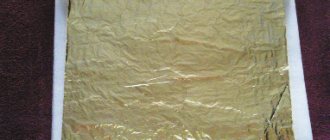The widespread use of gold in industry is explained by the mass of unique physical and chemical properties that this precious metal possesses. Its main consumer is jewelry, but there are other areas of use of this noble material. Once you understand what gold is made of, you can understand why it is so popular and constantly rises in price.
general information
Since gold became the main attribute of luxury and wealth, many people have tried to become its owners. But even in the distant past, this metal was considered very expensive, so only the wealthiest people could afford such a purchase. To reduce the cost of gold products and make them available to a wider group of society, medieval alchemists carried out all sorts of experiments and research.
Through many years of work, they managed to transform one element into another, but this does not mean that anyone can easily turn an aluminum spoon into gold. What is gold made from, and is it really possible to implement such an idea? Such an interesting topic has always caused a lot of disagreement and speculation among enthusiasts.
The history of the precious material dates back to ancient times. Translated from Latin, aurum (Au) means “yellow.” Many centuries ago, craftsmen who produced jewelry were amazed at the unique physical and chemical properties of such raw materials. This is about:
- High softness and ductility.
- Relatively low values of chemical activity.
- Availability in the natural environment.
Few people know that in its pure form, gold is a rather soft material that can be processed without any specific equipment. Initially, gold products were created using the forging method, which made it possible to make very thin sheets, a fraction of a millimeter in diameter. At the same time, the melting point remained very high - more than 1064 degrees Celsius. The element itself is characterized by high volatility and begins to evaporate long before boiling.
Most jewelry is made from various alloys rather than pure gold. Their composition may include the following elements :
- Copper.
- Silver.
- Platinum.
At the same time, pure gold has found application in technology, since radio components, microcircuits and other products are created on its basis.
But the percentage of industrial use of the metal is only 10% of the total. The rest belongs to state gold and foreign exchange funds, private owners and jewelry companies.
Deposits and their classification
The origin of our precious metal in deposits depends on the type of rock:
- Gold-quartz formations. Confined to fault zones. The metal distribution is uneven; enriched areas called “bonans” or “ore pillars” are formed.
- Deposits of gold-polysulfide-quartz formation. They are confined to granitoid and subvolcanic complexes. Average metal content is 10-15 g/t.
- Gold-larchite deposits. These include the Khaak-Sairskoye (Tuva), Mechnikovskoye, Kirovskoye (Ural) fields.
- Gold-sulfide deposits. Associated with volcanic-sedimentary strata.
- Porphyry gold deposits. This type includes the Bereznyakovskoye (Ural), Yubileinoye (Kazakhstan), Kyzyk-Chadr (Tuva) deposits.
- Deposits of oxidation zones. They are confined to the upper horizons of sulfide deposits in many sulfide deposits.
- Placer deposits often accompany primary gold fields. The length of placers is from 200-300 meters, less often 3-5 km. The width of the placers is 20-30 meters, less often - 100-300 meters. According to the conditions of occurrence, there are placers associated with river beds, floodplains, terraces, valleys, and intermountain depressions.
The world's largest gold deposit is located in South Africa. According to some reports, up to half of the world's production is obtained here.
Is there a lot of gold on Earth?
Many analysts believe that reserves of the mined “despicable metal” are difficult to calculate.
Experts give figures that vary by orders of magnitude (from 155,000 tons to 2.5 million tons).
There are countries where illegal gold mining is thriving, while other states prefer to keep production volumes secret. The principle “don’t count my money” works both for individual citizens and at the state level.
Industrial significance
One of the key areas where gold is used is industrial production. The particular importance of the precious metal in this branch of human activity is due to its specific properties, namely malleability and ductility. They make it possible to create micron wire and ultra-thin foil sheets from raw materials.
Gold is also characterized by a high degree of resistance to aggressive influences, which is important for the chemical field and electronics. Moreover, even low thermal and electrical conductivity does not make gold less in demand than copper.
Among the key branches of modern industry where gold is used, the following should be highlighted :
- Transport sector.
- Chemical and petrochemical production.
- Modern nanotechnology.
- Telecommunications areas.
- Electronics and production of measuring equipment.
- Energy industry.
Aurum is an indispensable solution for welding applications when creating advanced technical samples, thermocouples or small galvanometer components.
And although gold is inferior to many platinum group metals in terms of chemical and mechanical resistance, it remains indispensable for the manufacture of electrical conductors, especially in the field of microelectronics. Currently, based on this raw material, both gold conductors and electroplating of individual boards, microcircuits and connectors are created.
The finest gold wire in clothing and weapons
In ancient times, in many countries, craftsmen made the finest wires from precious metals, which were then used in jewelry. The most ancient examples of this use of gold were preserved in Egyptian burials. For example, during archaeological excavations in Abydos, researchers discovered a bracelet that consisted of two groups of precious beads connected by gold wire. Moreover, in this wire the thinnest cord of gold was intertwined with human hair. The diameter of this gold wire was only 0.33 mm. Even in Egypt in the third millennium BC, threads were actively made from gold to decorate clothes.
During the same period, jewelers in Mesopotamia created sophisticated gold jewelry. Archaeologists have found the oldest burial place of the queen or priestess Puabi in the city of Ur. Her clothes were richly decorated with gold items, and her head was adorned with a golden diadem with a wreath of gold-forged leaves and flowers. It was created from very thin gold wire and gold plates.
Ancient items made of gold wire have also been found in our area. In particular, similar samples were found in the following areas:
- Urals and Trans-Urals;
- Volga region;
- Northern Black Sea region;
- Altai.
In the last of these regions, Altai, in ancient times local tribes even knew how to make gold foil. They wrapped it around copper and bronze rings to make them more valuable. At the beginning of the 19th century, eight hundred meters from the world famous British Stonehenge (stone megaliths set in circles), archaeologists found a burial with a rich treasure. Having excavated a mound that was four thousand years old, scientists found in it a diamond-shaped clasp made of gold and an originally decorated dagger. It was the dagger, the handle of which was decorated with small gold pins, that attracted particular attention. Their number exceeds 140 thousand pieces. The width of each is only a third of one millimeter. They were made from the finest gold wire.
And in 1913, near Berlin, researchers dug up a treasure called the “Eberswalde treasure.” To this day, it is the largest such find discovered in Germany. The collection of antique gold jewelry consists of 81 items. They include 60 spiral gold bracelets, a gold bar and eight precious bowls. The total weight of the gold artifacts found exceeds two and a half kilograms. Scientists have not been able to establish exactly the purpose for which this treasure was buried. But some of his objects, in particular vases, led a number of researchers to believe that these were sacred objects. Vases made of gold were often given as gifts to the gods during the Bronze Age. Nowadays, this entire treasure is located in Russia.
Other areas
Also, the unique properties of gold have been used in the field of metal soldering, which is associated with the material’s ability to wet working surfaces well. Aurum is indispensable in the defense industry, as it is used in the manufacture of targets for nuclear research, coating of mirrors that are designed to operate in the far range of infrared radiation, and also in creating the shell of a neutron bomb.
When using electroplating with metal, any corrosion processes can be prevented, and the ability to create the thinnest gold plates is extremely in demand in the field of ultra-high vacuum research.
Being a good reflector of infrared rays, metal is also indispensable in the glass industry. Recently, the concept of metallization of double-glazed windows has become widespread, which involves inserting a thin film of gold into the window. When electric current is applied to such a surface, it becomes anti-fog. This is especially important in the production of glass products for large vehicles, including aircraft, electric locomotives and sea vessels.
As for the use of gold in the aviation and space industries, it sometimes causes controversial debates, since the material has a high specific gravity. But metal is intended for those tasks where the development of corrosion processes is unacceptable. Among them:
- Welding motor units.
- Connecting soldering points of electrical contacts.
- Coating windows of spacecraft with galvanic film.
Counterfeits, fakes...
We have to disappoint you: more than 70% of gold imported into Russia is counterfeit. A lot of gold jewelry is imported without the hassle of customs and assay inspections, so be careful when purchasing jewelry.
Sometimes it is simply impossible to distinguish a fake, despite checking with a detector. Especially if the jewelry is imported.
It is better to buy jewelry in reputable stores and let it be produced by well-known Russian or foreign companies. The cost of the product will be higher than at sales and in dubious places, but the likelihood of running into a fake is less.
When purchasing, pay attention to the presence of a brand (falsifying it is a crime; most scammers try not to mess with this).
Carefully examine the “underside” of the product - the neater it is, the more carefully the stones are fixed, the higher the guarantee of authenticity.
Jewelry industry
The key consumer of the valuable yellow metal is the jewelry industry. Since ancient times, gold items have been popular, being the personal belongings of the legendary pharaohs, as well as decorating their tombs.
The presence of gold jewelry could have different meanings. First of all, they were given the property of protecting the owner from all kinds of diseases, witchcraft and any other problems. In the 21st century, precious metal emphasizes the high status of its owner and is also an excellent aesthetic addition.
Despite the development of civilization and technological progress, the yellow metal is also in great demand, and it is unlikely that anything will ever change. Modern jewelry is distinguished by a wide variety of designs and textures. Today, rings, chains, cufflinks, rings and even pegs for guitar necks are created using gold. Most craftsmen do not use pure gold for their work, but all kinds of alloys. This is due to the fact that in its pure form the metal is too ductile and does not have the necessary resistance to certain influences.
In order to achieve the desired physical or chemical properties during the production of raw materials, various additives are added to it. These include: palladium, zinc, nickel and cobalt. Depending on the proportions used, the sample of the final alloy is determined.
Pure gold is highly resistant to corrosion, and properties such as shade and mechanical resistance are due to the content of other raw materials. Depending on the selected ratio of metals, jewelry can have three main shades: yellow, white and red. Statistics say that almost 50% of the use of gold in the world belongs to the jewelry industry.
Brief description of metal properties
Pure gold is an inert metal that hardly interacts with the environment. The material is not susceptible to oxidation processes and does not rust, is a good electrical conductor, and has high thermal conductivity. This is a soft metal, its hardness can be compared to a fingernail.
Despite this plasticity, it is a very heavy material: a golden ball with a diameter of about 4 cm weighs 1 kg. In terms of density, the substance ranks seventh along with tungsten.
Modern medicine
When understanding what gold is used for, one cannot fail to mention its role in modern medicine. Characterized by good malleability and lack of vulnerability to oxidative processes, aurum is indispensable for the dental industry. Even in the distant past, dentures and crowns were created on its basis. At the same time, as in the case of jewelry, different alloys of gold were used for such work.
These included silver, copper, zinc and platinum. Such proportions made it possible to achieve improved malleability and excellent anti-corrosion properties of the final product. In addition, it remained resistant to any mechanical stress, which is very important for prosthetics.
The next medical area in which gold is used is pharmacology. The metal is included in various medications that are necessary for the treatment of arthritis, malignant neoplasms, tuberculosis and other dangerous diseases.
A striking example of the use of metal in the pharmacological field is a water-soluble drug that is administered to a patient with chronic arthritis, as well as gold thiosulfate, necessary to combat erythematous lupus. Organic compounds of the precious material are used to effectively treat tuberculosis.
Radioactive gold has occupied a leading niche in the field of oncological diagnosis and treatment of malignant tumors . Various procedures in the field of modern aesthetic cosmetology are carried out using gold threads. Preparations containing gold effectively eliminate skin problems and promote their rejuvenation.
Modern science has reached such a level of development that almost every medical field contains traces of the use of gold alloys. And this trend is justified by the mass of useful properties of the precious metal, especially when it comes to oncology, where colloidal particles of isotopes of the material are used.
Application of gold alloys in particle accelerators
Gold and its various alloys are used not only in the production of highly reliable miniature contacts and radio tubes, but also in modern particle accelerators, also called colliders. They are giant annular chambers - pipes rolled into a bagel. The deeper the vacuum that can be obtained in such a chamber, the longer elementary particles can exist in it. To achieve this, along with other technical means, washers and sealing rings made of ductile gold are used. The camera joints are also soldered with gold.
Unconventional methods
Since ancient times, wearing gold jewelry was considered the best prevention of various ailments. People gave this material magical properties, claiming that it drives away evil spirits, protects its owner from witchcraft, the evil eye and any other problems.
The beneficial effects of gold on the human body are based on the following theses :
- The material helps improve memory and prevents the occurrence of atherosclerosis.
- Causes strengthening of the cardiovascular and circulatory systems.
- Fights colds.
- Raises overall tone and gives a person a feeling of vivacity and a surge of vitality.
However, the listed properties of the material do not always justify themselves when treating a particular patient. Here you need to take into account the individual factor and first consult with a specialist.
In some cases, wearing jewelry leads to various problems and only aggravates the problem. A negative reaction of the body to the material manifests itself in the form of elevated body temperature, pain in the intestines, kidney problems, and a depressive state. Similar symptoms have been identified in some patients who have been in constant contact with yellow treasure.
Financial instrument
For centuries, gold has been the most popular investment product, which is insured against any political or economic crisis. Each modern state has its own gold and foreign exchange fund with a certain reserve of this material. The total volume of reserves of all countries reaches 30,000 tons. Moreover, literally half a century ago this figure was 38 tons.
The presence of gold reserves determines economic independence, and is also an anti-crisis remedy that stabilizes the internal exchange rate of the national currency. A significant portion of gold reserves are located in the United States of America, with Germany in second place.
Currently, the use of gold in the industrial, medical and jewelry industries is very extensive. When wondering what gold is needed for, you should pay attention to the fact that the metal’s applications include the space industry, fashion trends in jewelry, and dental prosthetics.
Being an expensive material, gold continues to retain its investment, industrial and medical properties for many millennia. And it’s easy to guess that this trend will continue in the future, and the unique properties of aurum will find other niches of application.
Brief history of gold
The use of the material has been known since the third millennium BC. It has long been used to create jewelry, decorate weapons and household items, and mint coins.
Mass mining of the metal began in the 19th century, when gold rushes began to shake humanity on all inhabited continents. By the end of the century, miners were replaced by large firms that introduced industrial methods for obtaining pure metal from ore. Over the entire mining history, more than 161,000 tons were obtained.











